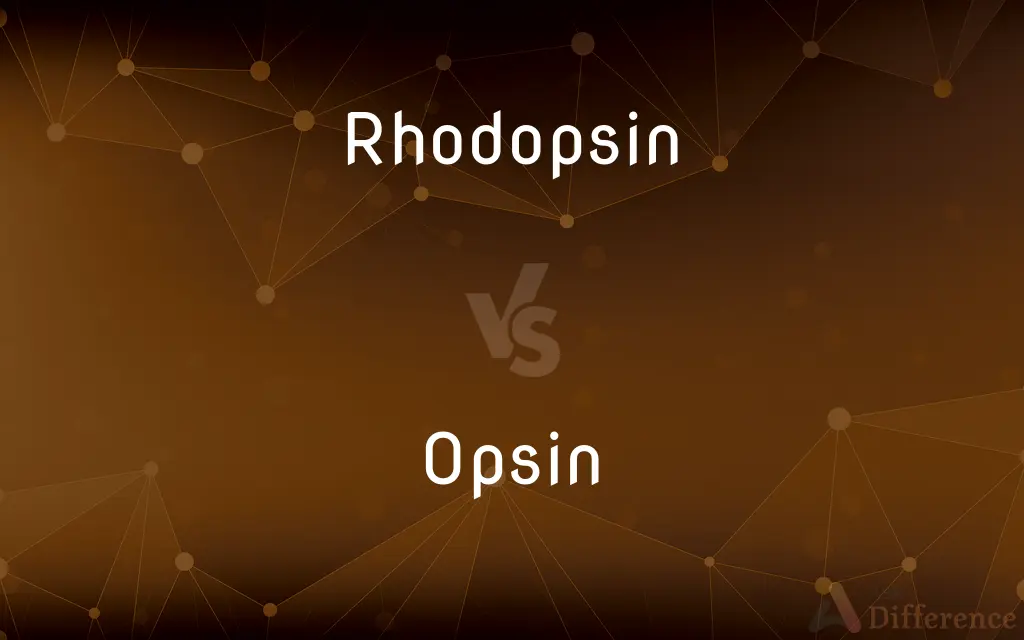Rhodopsin vs. Opsin — What's the Difference?
By Fiza Rafique & Urooj Arif — Updated on April 2, 2024
Rhodopsin is a light-sensitive pigment found in the rod cells of the retina, crucial for low-light vision. Opsin, a component of rhodopsin, is a protein that binds with retinal, a form of vitamin A, to form photopigments.

Difference Between Rhodopsin and Opsin
Table of Contents
ADVERTISEMENT
Key Differences
Rhodopsin, also known as visual purple, is essential for night vision and enables the eye to detect light in dark conditions. It consists of a protein called opsin and a light-sensitive retinal molecule. Opsin, in contrast, refers to a group of protein molecules found in photoreceptor cells of the retina, playing a key role in the formation of various photopigments by combining with different chromophores, including retinal.
When rhodopsin absorbs light, it undergoes a biochemical change that initiates the signal transduction pathway, leading to vision. This process, known as phototransduction, involves the conversion of light into electrical signals by the retina. Opsin, on the other hand, does not directly trigger phototransduction but is integral to the structure and function of rhodopsin and other photopigments by binding with chromophores to detect light.
The sensitivity of rhodopsin to low light makes it critical for scotopic vision, or vision under dim light conditions, enabling humans and animals to see at night. Opsins, while a fundamental part of rhodopsin and other photopigments, vary in type and function, contributing to the diversity of light detection, including color vision in cone cells through different opsin variations.
Rhodopsin's role is specific to rod cells in the retina, which are responsible for black and white vision in low-light conditions. Opsins are more broadly involved in the visual system, including in cone cells, where they are part of photopigments responsible for color vision and high-acuity vision in bright light.
The regeneration of rhodopsin after it is bleached by light exposure is a critical aspect of maintaining night vision. This process involves the recombination of opsin with retinal. The versatility of opsin proteins across different types of photoreceptor cells underlines their essential role in adapting vision to various light environments.
ADVERTISEMENT
Comparison Chart
Composition
Opsin protein + retinal molecule
Protein that binds with chromophores
Function
Initiates phototransduction in rod cells
Contributes to photopigment formation
Vision Type
Low-light (scotopic) vision
Involved in both low-light and color vision
Location
Rod cells of the retina
Photoreceptor cells (rods and cones)
Sensitivity
Sensitive to low light
Varies; different opsins sensitive to different light wavelengths
Compare with Definitions
Rhodopsin
Composed of opsin and retinal.
The combination of opsin and retinal forms rhodopsin.
Opsin
Protein component.
Opsin is a protein that binds with retinal to form photopigments.
Rhodopsin
Crucial for night vision.
Rhodopsin's high sensitivity to light enables night vision.
Opsin
Contributes to photopigment diversity.
The variety of opsin proteins allows for a wide range of light detection and vision capabilities.
Rhodopsin
Light-sensitive pigment.
Rhodopsin allows for vision in low-light conditions.
Opsin
Broader presence in the eye.
Opsins are present in both rod and cone cells, aiding in diverse visual functions.
Rhodopsin
Undergoes phototransduction.
Light exposure causes rhodopsin to initiate visual signal processing.
Opsin
Varied functions.
Different types of opsin contribute to color vision and light sensitivity.
Rhodopsin
Found in rod cells.
Rod cells contain rhodopsin, which is essential for detecting light in darkness.
Opsin
Not directly light-sensitive.
Opsin requires binding with chromophores like retinal to detect light.
Rhodopsin
Rhodopsin (also known as visual purple) is a light-sensitive receptor protein involved in visual phototransduction. It is named after ancient Greek ῥόδον (rhódon) for rose, due to its pinkish color, and ὄψις (ópsis) for sight.
Opsin
Opsins are a group of proteins made light-sensitive via the chromophore retinal (or a variant) found in photoreceptor cells of the retina. Five classical groups of opsins are involved in vision, mediating the conversion of a photon of light into an electrochemical signal, the first step in the visual transduction cascade.
Rhodopsin
Any of a class of reddish, light-sensitive pigments found in the retinal rods of the eyes of terrestrial and marine vertebrates, consisting of opsin and retinal. Also called visual purple.
Opsin
Any of various light-sensitive proteins, especially one that is a constituent of a rhodopsin or other visual pigment found in the retina of the vertebrate eye.
Rhodopsin
(biochemistry) A light-sensitive pigment in the rod cells of the retina; it consists of an opsin protein bound to the carotenoid retinal
Opsin
(biochemistry) Any of a group of light-sensitive proteins in the retina.
Rhodopsin
The visual purple. See under Visual.
Opsin
Retinal protein formed by the action of light on rhodopsin
Rhodopsin
A red photopigment in the retinal rods of vertebrates; dissociates into retinene by light
Common Curiosities
What is rhodopsin?
Rhodopsin is a photopigment in rod cells crucial for vision in low-light conditions.
What is opsin?
Opsin is a protein component of photopigments like rhodopsin, essential for light detection.
Why is rhodopsin important for night vision?
Its high sensitivity to low levels of light enables the eye to see in dark conditions.
What happens to rhodopsin when exposed to light?
It bleaches, triggering a biochemical process that converts light into visual signals.
Are opsin and rhodopsin the same?
No, opsin is a component of rhodopsin; rhodopsin consists of opsin and retinal.
How do different opsins contribute to vision?
Different opsins bind with chromophores to detect various light wavelengths, contributing to color vision and sensitivity to light.
Can opsin detect light by itself?
No, opsin must bind with a chromophore like retinal to become light-sensitive.
How does rhodopsin function in vision?
Rhodopsin absorbs light, undergoes a change, and initiates the conversion of light into electrical signals for vision.
What role does opsin play in phototransduction?
Opsin, as part of photopigments like rhodopsin, is crucial for the initial steps in converting light into electrical signals in vision.
Where are opsins found?
Opsins are found in photoreceptor cells of the retina, including both rods and cones.
How are opsin and rhodopsin related to color vision?
While rhodopsin is not directly involved in color vision, the variation in opsin types in cone cells enables the detection of different colors.
Can the human eye regenerate rhodopsin?
Yes, the human eye can regenerate rhodopsin through biochemical processes involving opsin and retinal.
Do all photoreceptor cells contain rhodopsin?
No, only rod cells contain rhodopsin; cone cells contain photopigments with different opsins for color vision.
How do variations in opsin affect human vision?
Variations in opsin proteins in cone cells lead to the ability to see a wide range of colors and respond to different light wavelengths.
Is rhodopsin found in animals other than humans?
Yes, rhodopsin is found in many animals, especially those with vision adapted to low-light conditions.
Share Your Discovery

Previous Comparison
Rhubarb vs. Tusky
Next Comparison
Monitoring vs. SurveillanceAuthor Spotlight
Written by
Fiza RafiqueFiza Rafique is a skilled content writer at AskDifference.com, where she meticulously refines and enhances written pieces. Drawing from her vast editorial expertise, Fiza ensures clarity, accuracy, and precision in every article. Passionate about language, she continually seeks to elevate the quality of content for readers worldwide.
Co-written by
Urooj ArifUrooj is a skilled content writer at Ask Difference, known for her exceptional ability to simplify complex topics into engaging and informative content. With a passion for research and a flair for clear, concise writing, she consistently delivers articles that resonate with our diverse audience.
















































